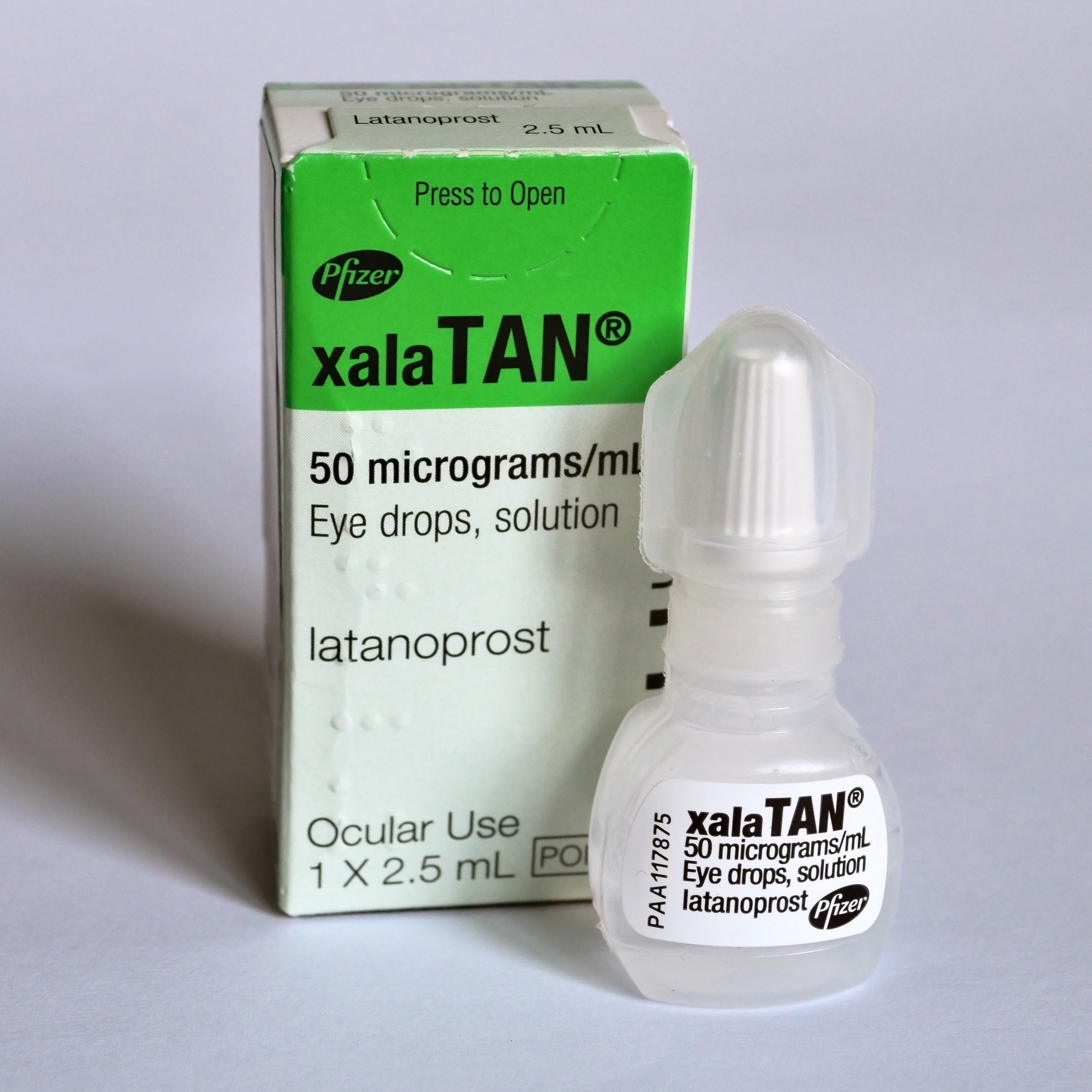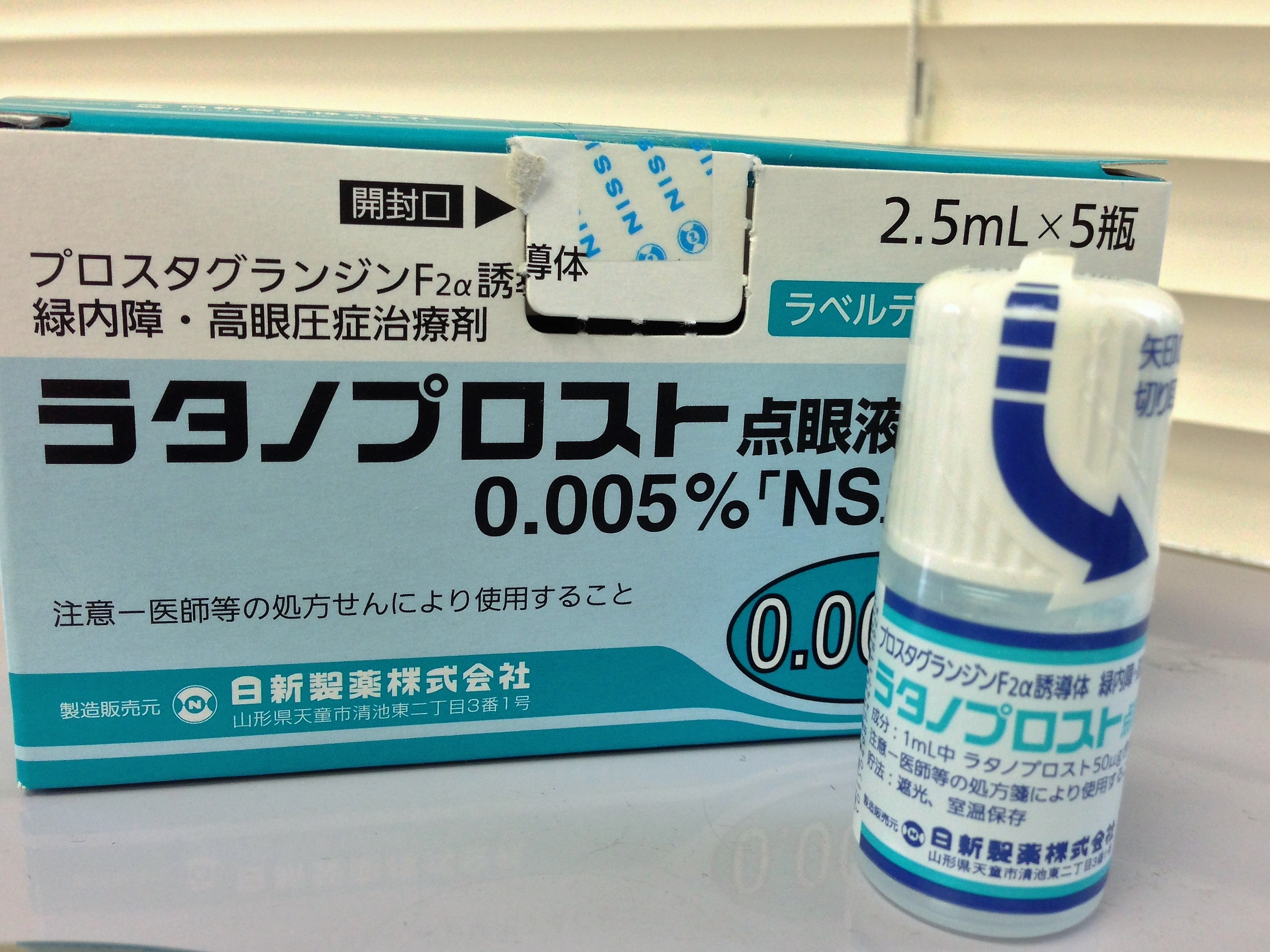latanoprost on:
[Wikipedia]
[Google]
[Amazon]
Latanoprost, sold under the brand name Xalatan among others, is a medication used to treat increased pressure inside the eye (intraocular pressure). This includes ocular hypertension and open-angle glaucoma. Latanaprost is applied as eye drops to the eyes. Onset of effects is usually within four hours, and they last for up to a day.
Common side effects include blurry vision, redness of the eye, itchiness, and darkening of the iris. Latanoprost is in the prostaglandin analogue family of medications. It works by increasing the outflow of aqueous fluid from the eyes through the uveoscleral tract.
Latanoprost was approved for medical use in the United States and the European Union in 1996. It is on the World Health Organization's List of Essential Medicines. Latanoprost is available as a

 In people with ocular hypertension (IOP ≥21 mm Hg) including open-angle glaucoma, treatment with latanoprost reduced IOP levels by 22 to 39% over 1 to 12 months’ treatment. Latanoprost is more effective than
In people with ocular hypertension (IOP ≥21 mm Hg) including open-angle glaucoma, treatment with latanoprost reduced IOP levels by 22 to 39% over 1 to 12 months’ treatment. Latanoprost is more effective than

generic medication
A generic drug is a pharmaceutical drug that contains the same chemical substance as a drug that was originally protected by chemical patents. Generic drugs are allowed for sale after the patents on the original drugs expire. Because the active ch ...
. In 2022, it was the 67th most commonly prescribed medication in the United States, with more than 9million prescriptions. It is available as a fixed-dose combination with netarsudil as netarsudil/latanoprost and with timolol
Timolol is a beta blocker medication used either by mouth or as eye drops. As eye drops it is used to treat increased pressure inside the eye such as in ocular hypertension and glaucoma. By mouth it is used for high blood pressure, chest ...
as latanoprost/timolol.
Medical uses
In the United States, latanoprost is indicated for the reduction of elevated intraocular pressure in people with open-angle glaucoma or ocular hypertension.Open-angle glaucoma

 In people with ocular hypertension (IOP ≥21 mm Hg) including open-angle glaucoma, treatment with latanoprost reduced IOP levels by 22 to 39% over 1 to 12 months’ treatment. Latanoprost is more effective than
In people with ocular hypertension (IOP ≥21 mm Hg) including open-angle glaucoma, treatment with latanoprost reduced IOP levels by 22 to 39% over 1 to 12 months’ treatment. Latanoprost is more effective than timolol
Timolol is a beta blocker medication used either by mouth or as eye drops. As eye drops it is used to treat increased pressure inside the eye such as in ocular hypertension and glaucoma. By mouth it is used for high blood pressure, chest ...
0.5% twice daily in 3 of 4 large (n = 163 to 267) randomised, double-blind trials. Latanoprost demonstrated a stable long-term IOP-lowering effect in 1- or 2-year continuations of these trials, with no sign of diminishing effect during prolonged treatment.
Meta-analysis
Meta-analysis is a method of synthesis of quantitative data from multiple independent studies addressing a common research question. An important part of this method involves computing a combined effect size across all of the studies. As such, th ...
suggests that latanoprost is more effective than timolol in lowering intraocular pressure (IOP). However, it often causes iris pigmentation. While current evidence suggests that this pigmentation is benign, careful lifetime evaluation of patients is still justified.
Closed-angle glaucoma
People who had elevated IOP despite iridotomy and/or iridectomy (including people of Asian descent), latanoprost was significantly more effective than timolol in two double-blind, monotherapy trials (8.2 and 8.8 mm Hg vs 5.2 and 5.7 mm Hg for latanoprost vs timolol at 12 and 2 weeks, respectively).Adverse effects
Listed from most to least common: * > 5–15%: blurred vision, burning and stinging, conjunctival hyperemia, foreign body sensation, itching, increased (brown) pigmentation of the iris (causing heterochromia), punctate epithelial keratopathy * 4%: cold or upper respiratory tract infections, flu-like syndrome * 1–4%: dry eyes, excessive tearing, eye pain, lid crusting, lid edema, lid erythema (hyperemia), lid pain,photophobia
Photophobia is a medical symptom of abnormal intolerance to visual perception of light. As a medical symptom, photophobia is not a morbid fear or phobia, but an experience of discomfort or pain to the eyes due to light exposure or by presence o ...
* 1–2%: chest pain, allergic skin reactions, arthralgia, back pain, myalgia
* < 1 % (only severe or life-threatening effects): asthma, herpes keratitis, iritis, keratitis, retinal artery embolus, retinal detachment, toxic epidermal necrolysis
Toxic epidermal necrolysis (TEN), also known as Lyell's syndrome, is a type of severe skin reaction. Together with Stevens–Johnson syndrome (SJS) it forms a spectrum of disease, with TEN being more severe. Early symptoms include fever and f ...
, uveitis
Uveitis () is inflammation of the uvea, the pigmented layer of the eye between the inner retina and the outer fibrous layer composed of the sclera and cornea. The uvea consists of the middle layer of pigmented vascular structures of the eye and ...
, vitreous hemorrhage from diabetic retinopathy
Diabetic retinopathy (also known as diabetic eye disease) is a medical condition in which damage occurs to the retina due to diabetes. It is a leading cause of blindness in developed countries and one of the lead causes of sight loss in the wor ...
*A single case report
In medicine, a case report is a detailed report of the symptoms, signs, diagnosis, treatment, and follow-up of an individual patient. Case reports may contain a demographic profile of the patient, but usually describe an unusual or novel occurrenc ...
links latanoprost use to the progression of keratoconus.
Research suggests that wiping the eye with an absorbent pad after the administration of eye drops can result in shorter eyelashes and a lesser chance of hyperpigmentation in the eyelid, compared to not wiping off excess fluid.
Pregnancy
Interactions
Interactions are similar to other prostaglandin analogs. Paradoxically, the concomitant use of latanoprost and bimatoprost or other prostaglandins may result in increased intraocular pressure. Non-steroidal anti-inflammatory drugs (NSAIDs) can reduce or increase the effect of latanoprost.Latanoprost .Pharmacology
Mechanism of action
Like other prostaglandin analogues, latanoprost acid is an analog of prostaglandin F2α that acts as a selectiveagonist
An agonist is a chemical that activates a Receptor (biochemistry), receptor to produce a biological response. Receptors are Cell (biology), cellular proteins whose activation causes the cell to modify what it is currently doing. In contrast, an R ...
at the prostaglandin F receptor. Prostaglandins increase the sclera's permeability to aqueous fluid. By giving latanoprorost, it increases prostaglandin's scleral activity, increasing outflow of aqueous fluid and lowering intraocular pressure. The outflow of aqueous fluid would reduce the intraocular pressure in the eye, reducing the likelihood of complications such as optic nerve damage and visual field loss.
Pharmacokinetics
Latanoprost is absorbed well through the cornea. As an ester prodrug, it completely hydrolyses to the active latanoprost acid upon absorption to become biologically active. Highest concentrations of the acid in the aqueous humour are reached two hours after application, lowering of intraocular pressure starts after 3 to 4 hours, with its highest effect found after 8 to 12 hours, and its effect still present for at least 24 hours. When latanoprost acid reaches the circulation, it is quickly metabolised in the liver by fatty acidbeta oxidation
In biochemistry and metabolism, beta oxidation (also β-oxidation) is the catabolic process by which fatty acid molecules are broken down in the cytosol in prokaryotes and in the mitochondria in eukaryotes to generate acetyl-CoA. Acetyl-CoA enter ...
to 1,2-dinor- and 1,2,3,4-tetranor-latanoprost acid; blood plasma half life is only 17 minutes. The metabolites are mainly excreted via the kidney, with 88% of the topical dose and 98% of an intravenous dose being recovered in the urine respectively.
The activation and deactivation pathway is analogous to the one of tafluprost (at least up to the tetranor-metabolite); compare Tafluprost#Pharmacokinetics.
Chemistry
Stability
Latanoprost exhibits thermal and solar instability. The concentration of latanoprost stored at 50 °C will decrease by 10% every 8.25 days. When stored at 70 °C the concentration will decrease by 10% every 1.32 days. Ultraviolet light, for example in sunlight, causes rapid degradation of latanoprost.Society and culture
Legal status
Latanoprost was approved for medical use in the United States and the European Union in 1996. In September 2023, the Committee for Medicinal Products for Human Use of theEuropean Medicines Agency
The European Medicines Agency (EMA) is an agency of the European Union (EU) in charge of the evaluation and supervision of pharmaceutical products. Prior to 2004, it was known as the European Agency for the Evaluation of Medicinal Products ...
adopted a positive opinion, recommending the granting of a marketing authorization for the medicinal product Catiolanze, intended for the reduction of elevated intraocular pressure in adults with open angle glaucoma or ocular hypertension and in children from four years and adolescents with elevated intraocular pressure and pediatric glaucoma. The applicant for this medicinal product is Santen Oy. Catiolanze was approved for medical use in the European Union in November 2023.
Brand names
Latanoprost is sold under many brand names including Xalatan, Iyuzeh, Xelpros, and Catiolanze. In the US, Xalatan is marketed by Viatris after Upjohn was spun off from Pfizer.Cosmetic use
* Lengthening and thickening of the eyelashes (used, like bimatoprost, in the cosmetic industry as eyelash growth enhancers).References
{{Authority control Alkene derivatives Carboxylate esters Cyclopentanes Hair loss medications Isopropyl esters Ophthalmology drugs Drugs developed by Pfizer Prostaglandins Triols World Health Organization essential medicines Wikipedia medicine articles ready to translate